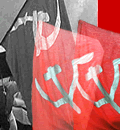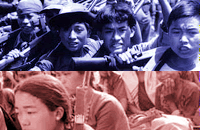|
The
People's War in Nepal: Maoists' Strategy
|
| Nepal's
Maoists: Purists or pragmatists? |
 |
International
Crisis Group: Kathmandu/Brussels, 18 May 2007
EXECUTIVE
SUMMARY
Nepal's
Maoists have changed their strategy and tactics but not yet their goals.
In 1996 they launched a "people's war" to establish a communist republic
but ten years later ended it by accepting multiparty democracy; their armed
struggle targeted the parliamentary system but they are now working alongside
their former enemies, the mainstream parties, in an interim legislature
and coalition government. Their commitment to pluralistic politics and
society is far from definitive, and their future course will depend on
both internal and external factors. While they have signed up to a peaceful,
multiparty transition, they continue to hone alternative plans for more
revolutionary change.
Maoist
strategy is shaped by a tension between purity and pragmatism. Although
they stick to certain established principles, they have long been willing
to shift course if they identify strategic weaknesses. Their changed approach
was demanded by recognition of three critical flaws in their original plan:
(i)
they concluded their belief in military victory had been misplaced;
(ii)
they acknowledged they had misread the likelihood of determined international
opposition; and
(iii)
they woke up to the failures that caused the collapse of twentieth-century
communist regimes.
Despite
having an authoritarian outlook, the Maoists maintained a culture of debate
within their party; key issues have been widely discussed and hotly contested.
From the end of the 1990s, they have moved gradually toward a more moderate
stance. They changed positions in acknowledging the 1990 democracy movement
as a success (they had earlier characterised it as a "betrayal"), in abandoning
the immediate goal of a Mao-style "new democracy" and, in November 2005,
by aligning themselves with the mainstream parties in favour of multiparty
democracy.
The
Maoists have cultivated formerly hostile forces, such as the Indian government
and the staunchly anti-Maoist Communist Party of India (Marxist), to the
extent of alienating their foreign allies. Supporters such as the Revolutionary
Internationalist Movement and Indian Maoists had backed their insurgency
but have been vocally critical of the compromises made in the peace process.
They think their Nepali comrades have betrayed fundamental principles and
thrown away the practical advantages they had secured through their armed
struggle.
For
Nepal's Maoists, however, the balance sheet at the end of ten years of
"people's war" is more complex. They believe they have secured some lasting
advantages, from their own dramatic rise to influence (with a support base
and military force hardly imaginable in 1996) to their reshaping of the
national political agenda (promoting formerly taboo causes such as republicanism
and federalism). But the course of the war persuaded most of their leadership
that they could not go it alone and would have to be more flexible if they
were to build on these gains.
The
peace process has forced practical and theoretical rethinking. Leaders
have tried to present a more moderate image as they balance complex equations
of domestic and international support and opposition. Maoist ministers
have to cooperate with colleagues from other parties and work with the
bureaucracy even as they plan a possible insurrection and plot to isolate
"regressive" opponents. Ideologically, they define the peace process as
a transitional phase in which they can destroy the "old regime" and restructure
the state. They justify this by saying their acceptance of a bourgeois
"democratic republic" is only a stepping stone on the way to a true "people's
republic". Leaders argue that they can create a new form of "peaceful revolution"
that is true to their communist aims but reflects the reality of Nepal's
politics.
It
is tempting to brand the Maoists as either rigid radicals or unprincipled
opportunists but neither characterisation explains the whole picture. Their
threats to revert to mass insurrection satisfy traditionalists in their
own movement and cannot be ignored. But leaders who have fought hard to
forge a new approach will be loath to turn their backs on the hard-won
advantages they have secured through compromise. They know they face internal
opposition but believe they can hold the line as long as the peace process
maintains momentum and allows them to achieve some of their headline goals.
Their
likely behaviour as the process moves forward, therefore, will depend upon
the role of other political actors as much as their own decisions. If the
mainstream parties keep up a strong commitment to the constituent assembly
process, the Maoists will find it hard to back out. If this route is blocked,
the Maoists may find their effort at controlled rebellion slipping into
renewed conflict beyond their leaders' control. If this were to happen,
the Maoists themselves would be big losers. But so would the democratic
parties and, even more so, the people of Nepal.
| Source: International
Crisis Group May 2007 |
 |
|





